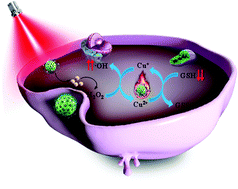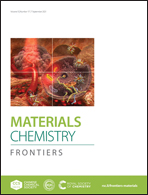A Cu2+ doped mesoporous polydopamine Fenton nanoplatform for low-temperature photothermal therapy†
Abstract
Traditional photothermal therapy requires heating the tumor tissue to high temperature for cancer cell inhibition, which may restrict its therapeutic efficiency and cause serious side effects. Herein, we demonstrated a Cu2+ doped mesoporous polydopamine (CuPDA) Fenton nanoplatform for efficient cancer therapy under mild NIR laser irradiation. Cu sites in CuPDA could not only catalyze the H2O2 self-sufficient Fenton reaction and deplete the intratumoral GSH, but also elevate the photothermal conversion effect of PDA. The mild hyperthermia mediated by CuPDA could further accelerate the Fenton reaction in turn. Moreover, the mesoporous structures of CuPDA could expose abundant catalytic sites of Cu2+ and facilitate the diffusion of diverse substrates, leading to an improved efficacy in chemodynamic therapy. The available inner surface enabled a very high loading capacity of β-lapachone with loading efficiency of 21.8%, which could induce intracellular H2O2 accumulation. Therefore, the CuPDA-based nanoplatform could effectively inhibit the proliferation of cancer cells both in vitro and in vivo under low-power NIR irradiation and may serve as a promising candidate for low-temperature photothermal therapy.



 Please wait while we load your content...
Please wait while we load your content...